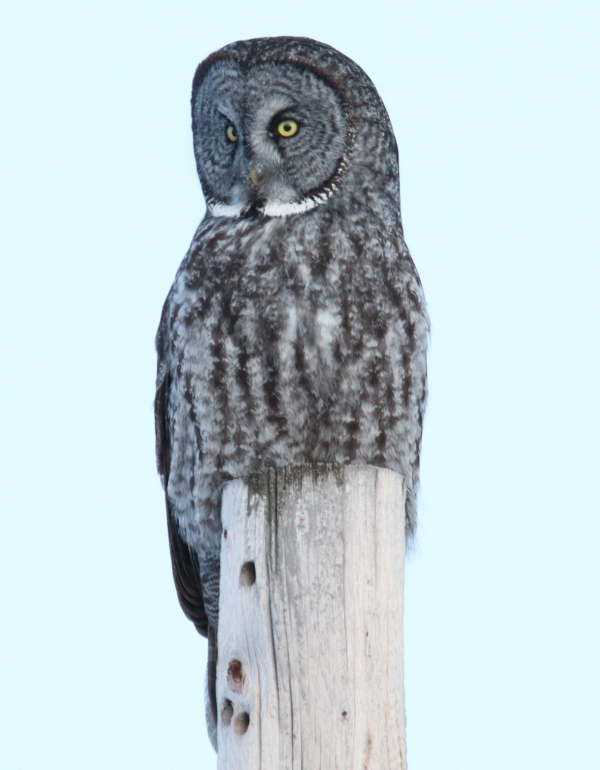
With only dim light available after sunset, it seemed the chance of a quality photo was impossible, but when the Great Gray Owl landed close in front of me, I was compelled to take a series of photographs with the hope that one might turn out (600mm zoom lens, f-7 aperture, 1/50 shutter speed, 800 ISO).
|
So often when I have a bird perched before me I find myself saying, or thinking: “Turn; turn; turn;” hoping to get another angle or to better emphasize a hawk’s hooked beak or a cardinal’s crest. Recently, I found myself in the enviable position of photographing a Great Gray Owl perched before me for a couple minutes, and as it scanned the area, that’s all the action I managed to record as the grand owl calmly scanned the area. But isn’t that enough? You bet; and I was thrilled just to get one photo of such a desirable Northwoods bird, much less an extended portrait session.
Usually, I would pick a single image of the bird to share with you, but in this case, I’m going to share a series of images, including a rarely published photo of the owl taken when it turned its head all the way around, 180 degrees. During this photo period I really didn’t need to voice or think “turn, turn, turn;” the owl performed the rather subdued action automatically as part of its search for small rodents. But there’s much more to the story and technical side of this photo session to share.
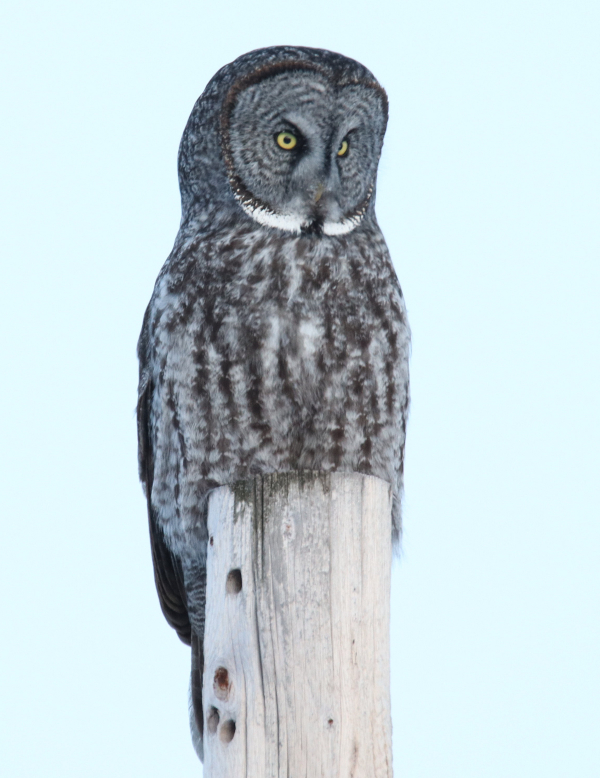
With a 1/50 super-slow shutter speed, the resulting photographs are a true holiday gift (600mm zoom lens, f-7 aperture, 1/50 shutter speed, 800 ISO).
|
The day before the official first day of winter, I reached the birding hotspot, the Sax-Zim Bog in northeast Minnesota just before sunrise, initially headed for the area where I have had the best luck finding Great Gray Owls in the past. And would you believe that while still a half-mile away I could see the silhouette of one of the big owls perched on a tall snag between me and the rising sun. But all I would get was a fairly distant documentary photo of the owl with the bright light of the rising sun behind it. Just seeing the Great Gray was quite a thrill and an excellent start to the day of birding; but I also hoped that the big owl might be around before sunset when the sun would be positioned behind me to provide afternoon light – if the owl returned to the area.
After a few minutes the owl made a short flight, hovered a moment, dipped lower, hovered, and dropped into the tall sedges of a frozen marsh. Presumably it caught a small rodent, but I waited about 15 minutes for it to reappear, before imagining it might have retired to a day bed among the cattails. I enjoyed a busy and fruitful day within the expanse of the Bog, photographing White-winged Crossbills, Canada Jays, Purple Finches, Ruffed Grouse, and many common eastern feeder birds.
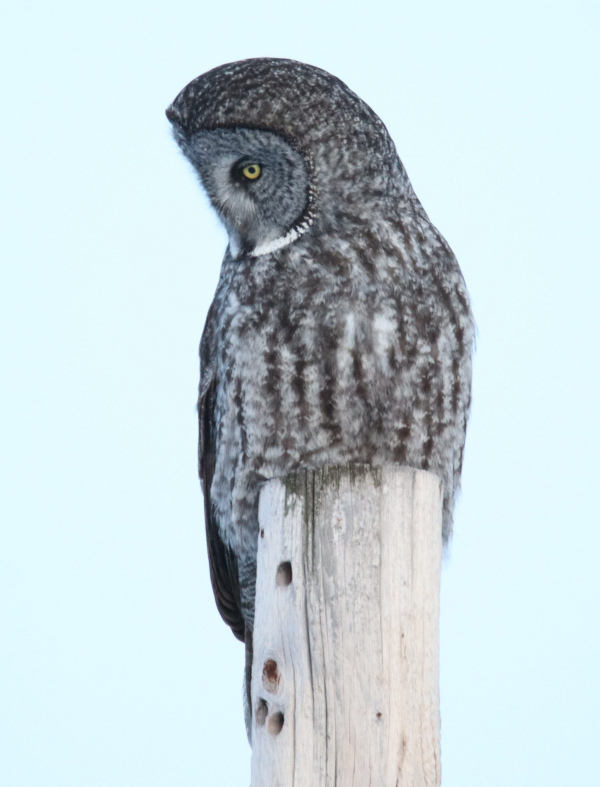
While the Great Gray Owl scanned the area, I did what I could to adjust my camera settings, but the changes don’t show an appreciable difference in the quality or colors of the photos (600mm zoom lens, f-6 aperture, 1/100 shutter speed, 1600 ISO).
|
By the time the afternoon sun was low I returned to see if the Great Gray Owl was re-activated. There was no sign of an owl during my first drive by, or my second, so I checked another location where other birders observed a Great Gray that morning. Without seeing anything but a couple Common Ravens – classic birds of the Northwoods – I decided I should take a last look to see if the morning’s Great Gray Owl was active before beginning my return drive toward Dakota. The only catch was that it was already several minutes after sunset, so even if an owl was present I figured any photographs would be limited to poor documentary photos at best under the subdued light conditions. But would the owl be present?
After Sunset
Again, I could see the owl when I was still a half-mile away, but even though I positioned myself between the owl and the remnant light of the sunset, I expected there was almost no light to create a quality photograph by that time. Even so, I took a couple photos from a distance as the Great Gray Owl perched on a tall snag not far from where I found it at sunrise. Knowing I was working with a very low shutter speed (or should I call it “shutter-slow”), I did what I could to steady my camera lens on my half-open car window and by holding my breath when taking individual photos, as usual.
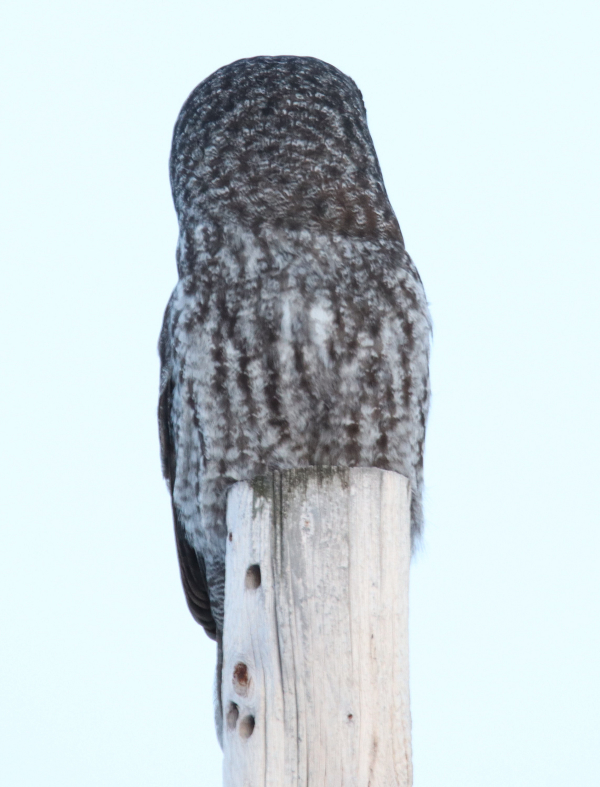
As the big owl turned its head, I wanted to photograph its full repertoire of positions, including the back of its head as its body was turned forward, a view that is rarely published (600mm zoom, f-7 aperture, 1/50 shutter speed, 800 ISO).
|
Suddenly the owl took flight, surprising me by flying straight in my direction and landing on a wooden pole adjacent to the road – close. I quickly focused on the impressive owl and took a few photos as it turned, turned, turned. I took a series of photos as the owl searched north, south, west, east, up, and down over a few exciting minutes.
In the heat of the moment, I took a quick peek at the LCD monitor on the back of my camera and saw the photos might have some promise. Then I checked the shutter speed to see it was at 1/50 with the aperture set at f-7. I quickly dialed the aperture as low as possible to f-6, and changed the ISO from 800 to 1600, and crossed my fingers. I took a few more photographs as the owl continued its quest for food, but with no voles in sight (I guess), the big gray took flight to land on the top of a bare tamarack tree a short distance away – close to its position when I first sighted the Great Gray that morning.
Woo-wee, I didn’t expect that kind of action, and it all happened pretty quickly, giving me a considerable jolt of adrenaline. As for the photos, I certainly didn’t expect to get quality of photos of the Great Gray Owl after sunset; but the images were as good as I could hope for under the best of conditions. Actually, I’m not sure I could have managed better portrait photos of the big owl a half-hour earlier when the sunlight was direct and unfiltered. Even the sky behind the owl shows light-blue color in some photos, whiter in others.
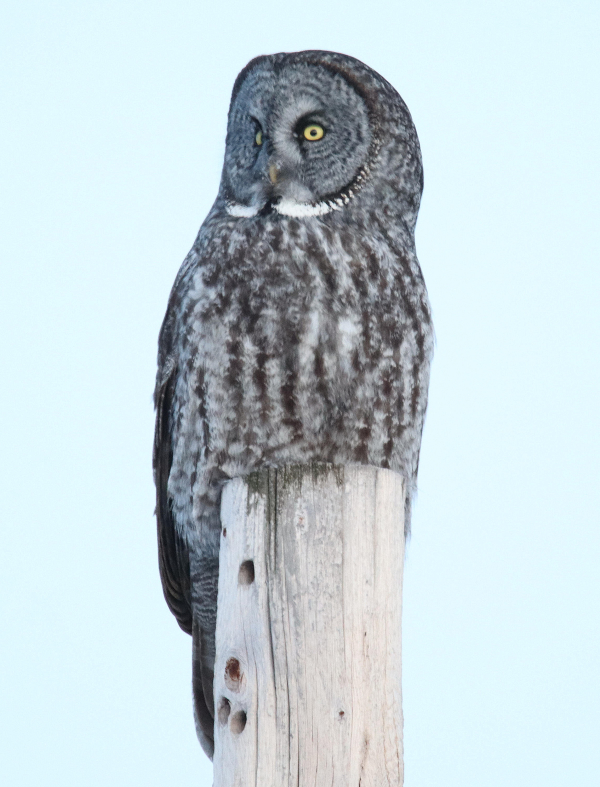
I guess the moral of the story is to take the photographs first, and ask questions later (600mm zoom lens, f-6 aperture, 1/100 shutter speed, 1600 ISO).
|
I must credit the fact that for some months I’ve been using a center-point light meter setting, so when I focused on the owl’s chest, the meter apparently worked the best it has ever worked before. I’m very surprised at the quality of the photos in such a low light situation; I actually kind of took the photos out of necessity, with a hint of desperation, because I couldn’t pass up the chance to take photos of a Great Gray Owl in such a close photo situation. I guess the moral of the story is to take the photographs first, and ask questions later.
So I must suggest: Take the photos, even if you think it’s out of desperation, beyond the chance to get anything more than a documentary photo, and see if your camera can prove you wrong – Mine Did! In the meantime, during the New Year I encourage you to seek out some different species, visit some new birding hotspots, and dedicate a little more time to searching out birds to photograph. I hope you managed to take a few (or many) bird photographs during the holiday period, and hope 2025 provides twice as many quality photos for you!
Article and Photographs by Paul Konrad
Share your bird photos and birding experiences at editorstbw2@gmail.com